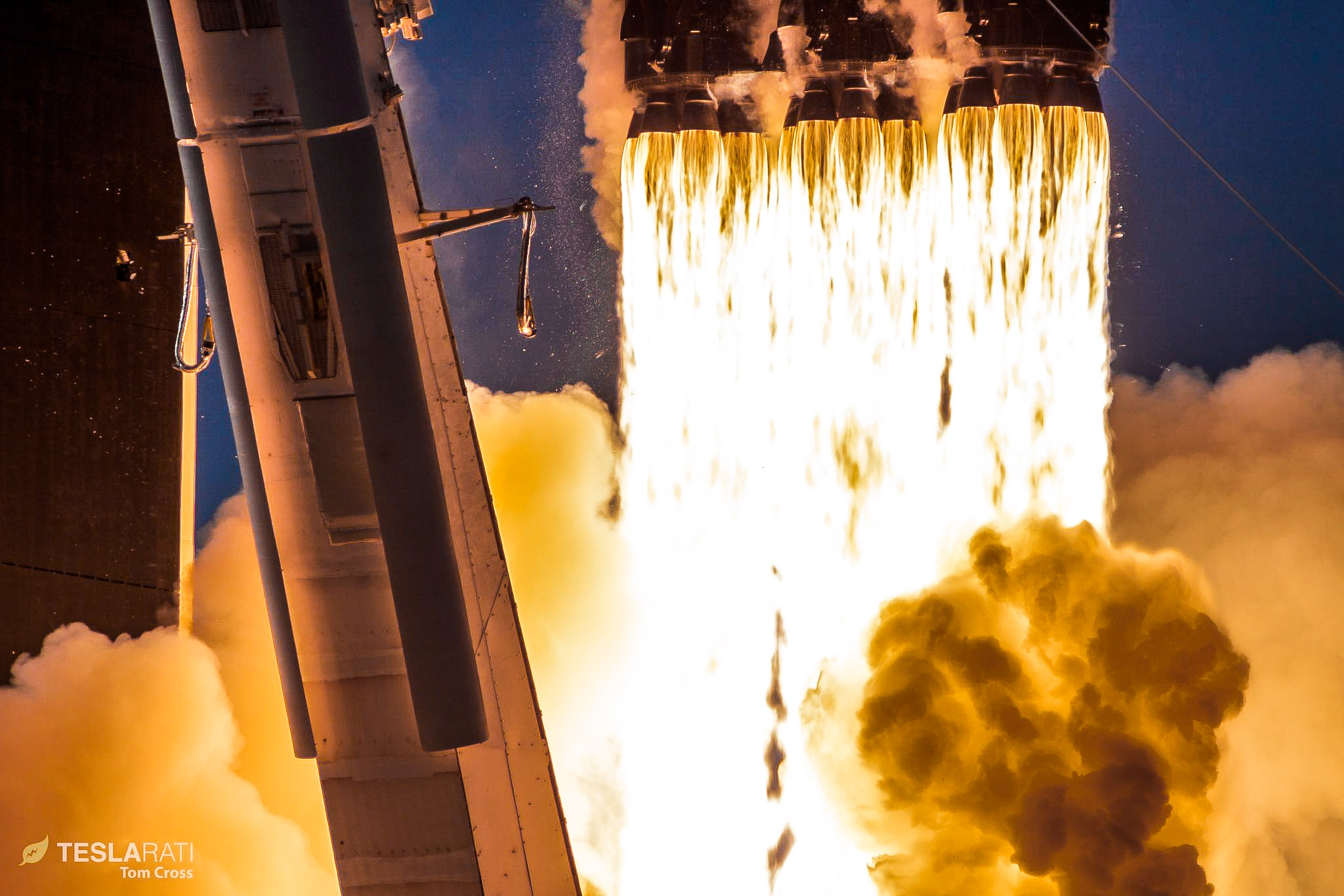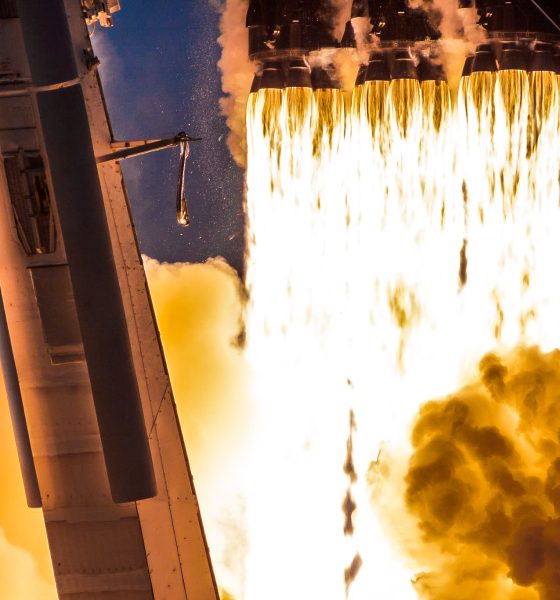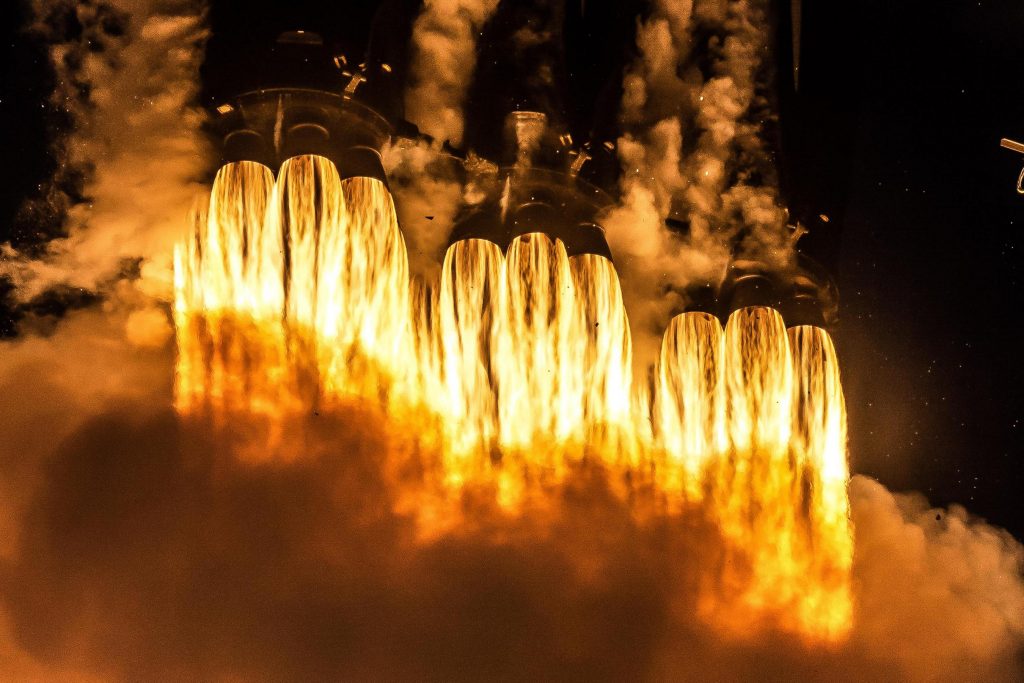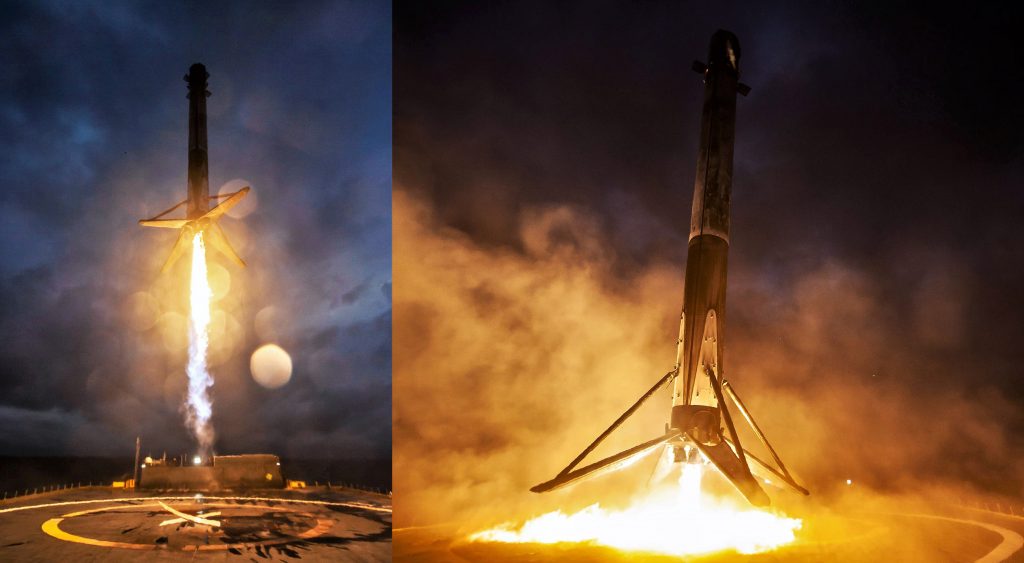

News
SpaceX’s next Falcon Heavy launch to feature first dual rocket landing of its kind
Hot on the heels of the revelation that SpaceX’s next Falcon Heavy launch is on schedule and will carry a small satellite copassenger, a US Space Force official has effectively confirmed that it will feature the first dual rocket landing of its kind.
Scheduled to launch no earlier than (NET) “late 2020”, likely November or December, an April 21st update from small satellite manufacturer Millenium Space Systems confirmed that SpaceX’s next Falcon Heavy mission is still on track. Formerly known as AFSPC-44 and now deemed US Space Force 44 (USSF-44), SpaceX’s Falcon Heavy rocket won the contract as part of a $297 million batch of three US military launches in February 2019.
USSF-44 was the second operational launch contract won by Falcon Heavy and will send a ~3.7 metric ton (~8200 lb) satellite and an unknown number of secondary spacecraft directly to geostationary orbit (GEO) – a first for SpaceX. As far as Earth-centric orbits go, a direct-to-GEO launch is uniquely complicated and energy-intensive for the rockets that must perform them. As a result, it’s long been suspected that Falcon Heavy’s first GEO launch would also coincide with another first for SpaceX rocket recovery, an educated guess that has now been (partially) confirmed by the USSF.

Over the course of Falcon Heavy’s operational history, the rocket has performed three successful launches, all involving triple-booster recovery attempts where two side boosters attempt to land at land-based pads and the lone center core aims for a drone ship landing hundreds of miles downrange. Of those missions, all three dual LZ-1/LZ-2 side booster landings have been flawless successes. The center core has had far less luck, however, fully missing its first and third drone ship landing attempts and successfully touching down on its second try only to tip over in high seas, damaging the rocket well beyond repair.


Thanks to the apparent challenges of center core recovery and the simple fact that Falcon Heavy doesn’t launch nearly as much as Falcon 9, none of the three custom, highly-complex boosters have survived to be reused or inspected intact. Until the center core recovery problem can be fixed, SpaceX will thus likely have to assume that it must build a new center booster for every future Falcon Heavy launch, even if a given mission permits a landing attempt.
Thankfully, there are some circumstantial benefits to be derived if SpaceX, for example, doesn’t even try to recover a Falcon Heavy center core. Speaking back in 2018, CEO Elon Musk revealed that Falcon Heavy could launch in a partially-reusable configuration – intentionally expending the center core and recovering both side boosters on two separate drone ships – with only a 10% cut to performance.
For a Falcon Heavy launch sending a heavy payload directly to a circular geostationary orbit (~35,800 km or ~22,250 mi), that could be a necessity. If that’s the case and Falcon Heavy Flight 4 will, in fact, feature a dual side booster landing attempt on two simultaneously-deployed drone ships, it will be a first for SpaceX rocket recovery. Even if it turns out that Falcon Heavy actually has the performance necessary to launch directly to GEO, expend the center core, and land both side boosters all the way back at SpaceX’s Cape Canaveral Landing Zones, it will still be an important step towards fully expanding Falcon Heavy’s flight-proven envelope.
Falcon Heavy’s next launch is expected to occur as few as 6-8 months from now.

News
Tesla FSD fleet is nearing 7 billion total miles, including 2.5 billion city miles
As can be seen on Tesla’s official FSD webpage, vehicles equipped with the system have now navigated over 6.99 billion miles.

Tesla’s Full Self-Driving (Supervised) fleet is closing in on almost 7 billion total miles driven, as per data posted by the company on its official FSD webpage.
These figures hint at the massive scale of data fueling Tesla’s rapid FSD improvements, which have been quite notable as of late.
FSD mileage milestones
As can be seen on Tesla’s official FSD webpage, vehicles equipped with the system have now navigated over 6.99 billion miles. Tesla owner and avid FSD tester Whole Mars Catalog also shared a screenshot indicating that from the nearly 7 billion miles traveled by the FSD fleet, more than 2.5 billion miles were driven inside cities.
City miles are particularly valuable for complex urban scenarios like unprotected turns, pedestrian interactions, and traffic lights. This is also the difference-maker for FSD, as only complex solutions, such as Waymo’s self-driving taxis, operate similarly on inner-city streets. And even then, incidents such as the San Francisco blackouts have proven challenging for sensor-rich vehicles like Waymos.
Tesla’s data edge
Tesla has a number of advantages in the autonomous vehicle sector, one of which is the size of its fleet and the number of vehicles training FSD on real-world roads. Tesla’s nearly 7 billion FSD miles then allow the company to roll out updates that make its vehicles behave like they are being driven by experienced drivers, even if they are operating on their own.
So notable are Tesla’s improvements to FSD that NVIDIA Director of Robotics Jim Fan, after experiencing FSD v14, noted that the system is the first AI that passes what he described as a “Physical Turing Test.”
“Despite knowing exactly how robot learning works, I still find it magical watching the steering wheel turn by itself. First it feels surreal, next it becomes routine. Then, like the smartphone, taking it away actively hurts. This is how humanity gets rewired and glued to god-like technologies,” Fan wrote in a post on X.
News
Tesla starts showing how FSD will change lives in Europe
Local officials tested the system on narrow country roads and were impressed by FSD’s smooth, human-like driving, with some calling the service a game-changer for everyday life in areas that are far from urban centers.

Tesla has launched Europe’s first public shuttle service using Full Self-Driving (Supervised) in the rural Eifelkreis Bitburg-Prüm region of Germany, demonstrating how the technology can restore independence and mobility for people who struggle with limited transport options.
Local officials tested the system on narrow country roads and were impressed by FSD’s smooth, human-like driving, with some calling the service a game-changer for everyday life in areas that are far from urban centers.
Officials see real impact on rural residents
Arzfeld Mayor Johannes Kuhl and District Administrator Andreas Kruppert personally tested the Tesla shuttle service. This allowed them to see just how well FSD navigated winding lanes and rural roads confidently. Kruppert said, “Autonomous driving sounds like science fiction to many, but we simply see here that it works totally well in rural regions too.” Kuhl, for his part, also noted that FSD “feels like a very experienced driver.”
The pilot complements the area’s “Citizen Bus” program, which provides on-demand rides for elderly residents who can no longer drive themselves. Tesla Europe shared a video of a demonstration of the service, highlighting how FSD gives people their freedom back, even in places where public transport is not as prevalent.
What the Ministry for Economic Affairs and Transport says
Rhineland-Palatinate’s Minister Daniela Schmitt supported the project, praising the collaboration that made this “first of its kind in Europe” possible. As per the ministry, the rural rollout for the service shows FSD’s potential beyond major cities, and it delivers tangible benefits like grocery runs, doctor visits, and social connections for isolated residents.
“Reliable and flexible mobility is especially vital in rural areas. With the launch of a shuttle service using self-driving vehicles (FSD supervised) by Tesla in the Eifelkreis Bitburg-Prüm, an innovative pilot project is now getting underway that complements local community bus services. It is the first project of its kind in Europe.
“The result is a real gain for rural mobility: greater accessibility, more flexibility and tangible benefits for everyday life. A strong signal for innovation, cooperation and future-oriented mobility beyond urban centers,” the ministry wrote in a LinkedIn post.
News
Tesla China quietly posts Robotaxi-related job listing
Tesla China is currently seeking a Low Voltage Electrical Engineer to work on circuit board design for the company’s autonomous vehicles.

Tesla has posted a new job listing in Shanghai explicitly tied to its Robotaxi program, fueling speculation that the company is preparing to launch its dedicated autonomous ride-hailing service in China.
As noted in the listing, Tesla China is currently seeking a Low Voltage Electrical Engineer to work on circuit board design for the company’s autonomous vehicles.
Robotaxi-specific role
The listing, which was shared on social media platform X by industry watcher @tslaming, suggested that Tesla China is looking to fill the role urgently. The job listing itself specifically mentions that the person hired for the role will be working on the Low Voltage Hardware team, which would design the circuit boards that would serve as the nervous system of the Robotaxi.
Key tasks for the role, as indicated in the job listing, include collaboration with PCB layout, firmware, mechanical, program management, and validation teams, among other responsibilities. The role is based in Shanghai.
China Robotaxi launch
China represents a massive potential market for robotaxis, with its dense urban centers and supportive policies in select cities. Tesla has limited permission to roll out FSD in the country, though despite this, its vehicles have been hailed as among the best in the market when it comes to autonomous features. So far, at least, it appears that China supports Tesla’s FSD and Robotaxi rollout.
This was hinted at in November, when Tesla brought the Cybercab to the 8th China International Import Expo (CIIE) in Shanghai, marking the first time that the autonomous two-seater was brought to the Asia-Pacific region. The vehicle, despite not having a release date in China, received a significant amount of interest among the event’s attendees.








